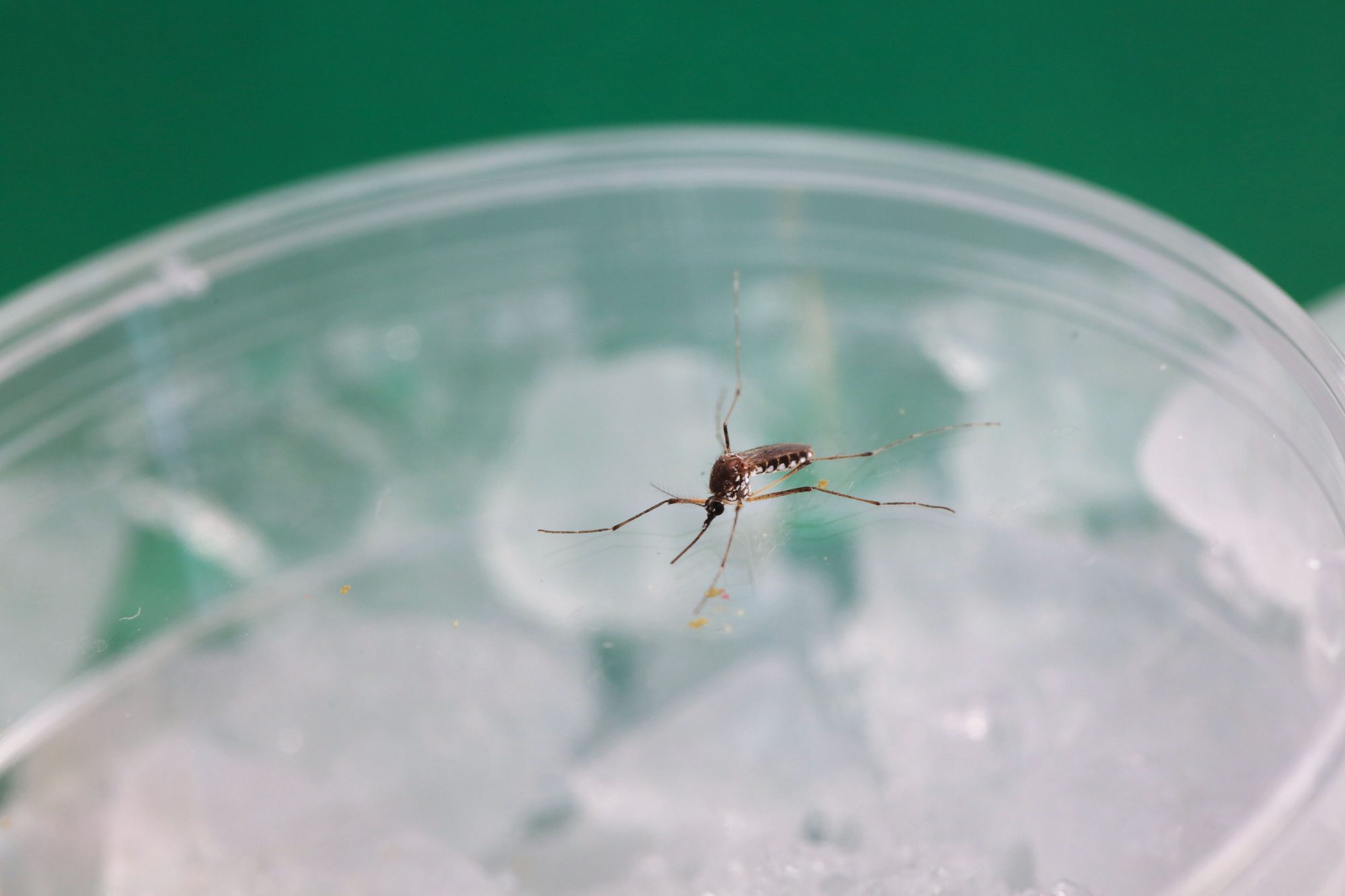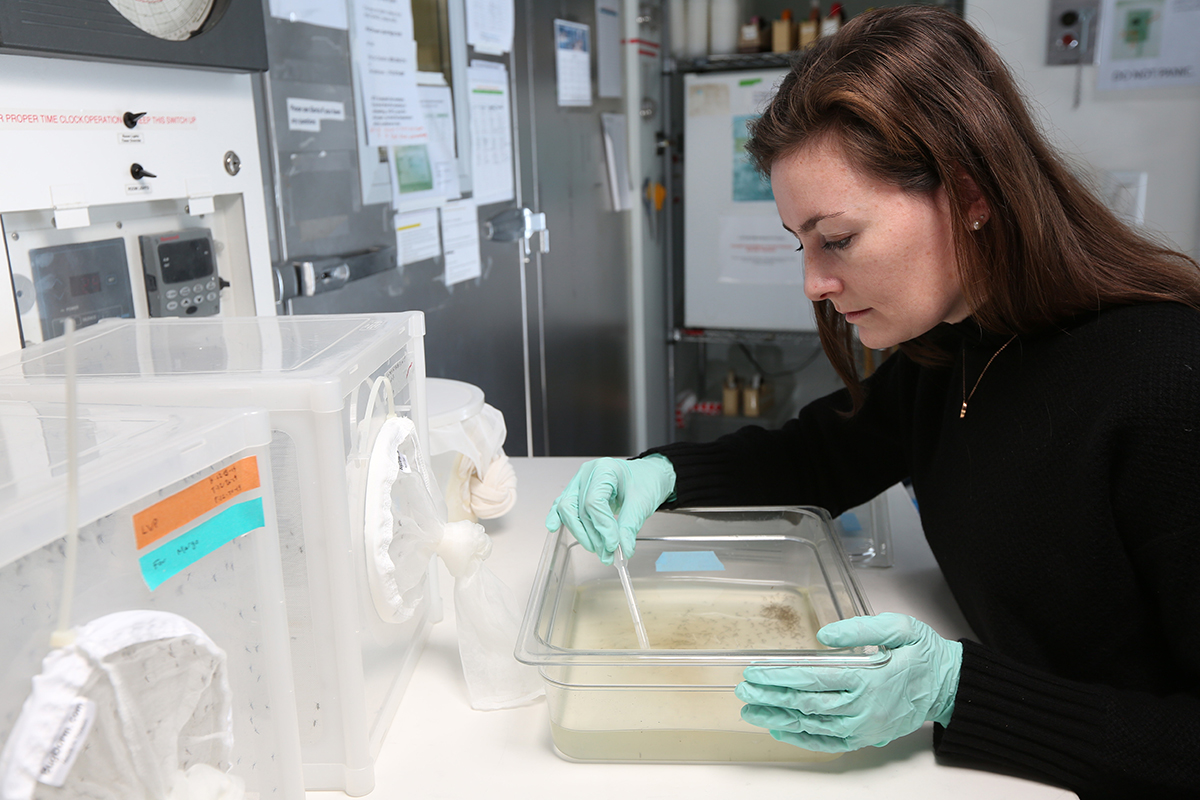Feature
This isn’t Drosophila
A lab is on a mission to defang Aedes aegypti, one of the world’s most dangerous mosquitos. Step one: make her a decent lab animal.
By Alexander GelfandLeslie Vosshall’s office on the fourth floor of Smith Hall is bright and welcoming, filled with contemporary art and flooded with sunlight. It is also a stone’s throw from a room containing tens of thousands of the deadliest animals on the planet: mosquitoes.
Female mosquitoes require blood to produce their eggs; and as anyone who has ever been eaten alive at a barbecue might suspect, some of them strongly prefer that of human beings. In addition to making mosquitoes a nuisance, this preference for human blood also makes them one of the most important disease vectors in the world: By passing microbes from person to person, these tiny pests kill more people every year than any other animal—including Homo sapiens itself. In 2015, 580,000 humans perished through homicide and war, while 830,000 died from mosquito-borne diseases.

Vosshall is on a mission to defang these lethal creatures. Since 2008, she has focused her research on Aedes aegypti, a mosquito that transmits such debilitating and potentially fatal viral diseases as yellow fever, dengue, chikungunya, and Zika to 400 million people annually.
Of course, humans have sought effective ways to repel, eradicate, and neutralize mosquitoes for centuries. But Vosshall brings something new to the field: a comprehensive strategy complete with cutting-edge techniques designed to pinpoint the very essence of the mosquito’s menace—the genes and neural circuits that compel these bloodsuckers to seek us out and bite us.
“Our mission is to understand everything we can about the female mosquito: how she finds us, how she bites us, and how we can stop her,” Vosshall says.
“A lot of people in the field said, ‘You’re an idiot. Aedes aegypti is a joke mosquito.’”
By zeroing in on some of the fundamental mechanisms driving Aedes’s host-seeking and blood-feeding behaviors, she and her team have already identified potential new interventions. Their work includes efforts to understand and interfere with the animal’s senses as well as its appetite. Yet when Vosshall first began investigating Aedes, plenty of mosquito experts thought she was making a mistake.
And there were times when she more or less agreed with them.
Planet Earth is rife with mosquitoes. By some estimates, they’re the third largest animal population, outnumbered only by termites and ants; there are at least 3,500 species worldwide. The most infamous of these, Anopheles, spreads malaria—a disease that by itself threatens half the world’s population and kills hundreds of thousands of people every year.
Traditionally, mosquito researchers have mainly studied Anopheles, so Vosshall’s decision a decade ago to focus instead on Aedes was met with skepticism.
“A lot of people in the field said, ‘You’re an idiot. Aedes aegypti is a joke mosquito,’” Vosshall recalls from the lab’s insectary, a temperature- and humidity-controlled room where swarms of mosquitoes flit about inside mesh-covered cages.
But after a deep dive into mosquito-research literature, Vosshall became convinced that Aedes would be easier to work with in the lab. And she was right; for reasons that no one can quite explain, the genetic and molecular techniques she has developed to study mosquitoes have turned out to work far better on Aedes than they do on Anopheles.
What’s more, the threat posed by Aedes has only increased with time. The past decade has seen an uptick in Eastern equine encephalitis, an Aedes-borne virus that kills 30 percent of those infected and leaves survivors with lifelong neurological problems. The Zika virus, which causes devastating birth defects in babies born to infected mothers, was declared an international public health emergency in 2016. And experts now warn that climate change will vastly expand the range of both Ae. aegypti and Ae. albopictus, a close relative with the potential to carry the same diseases over an even wider swath of the globe. (Unsettlingly, the latest predictions have the two mosquitoes menacing 49 percent of the world’s population by 2050.)
Few today would argue that Vosshall made a poor choice, though she herself may occasionally have had cause to regret it. She began her career working with a far more tractable insect: Drosophila melanogaster, the common fruit fly, whose genetics have been subject to research and manipulation for over a century. In this obliging model animal, Vosshall made important discoveries about the neuroscience of olfaction, a topic she has also explored among humans.
Although Vosshall knew that Ae. aegypti would be a far more challenging subject than Drosophila, the mosquito nonetheless presented her with difficulties she could not have anticipated. Some of these had to do with the extraordinary complexity of the animal’s host-seeking behaviors, which proved devilishly hard to unpack. And some had to do with unforeseen technological challenges that initially prevented Vosshall from conducting the kinds of experiments that might have unpacked them.
Mosquitoes excel at sniffing out their prey; a mélange of odors in our breath and sweat will alert them to our presence from 100 feet away. Yet while the insect’s olfactory system is a remarkably sophisticated phenomenon in itself, it is but one part of an even more complicated mosaic of sensory inputs that draws mosquitoes to us. Research by Vosshall and others has shown that the insects rely on a wide range of cues to track us: Odor, heat, and vision are all integrated in the mosquito brain to paint a giant bull’s-eye on our backs, with the carbon dioxide in our breath acting like a kind of all-purpose sensory umami that enhances other cues through its mere presence.

Previously, mosquito researchers had relied primarily on observational and behavioral experiments to investigate such phenomena: slathering a chemical on a volunteer’s arm to see if it would repel the animals, for instance, or laying out some nice, warm blood with and without CO2 present to see if it would entice the bloodthirsty pests. But Vosshall wanted to create genetically modified mosquitoes that lacked specific traits, such as a proper sense of smell or the ability to sense CO2, to determine precisely how those traits help Aedes find us—and whether selectively knocking them out might be enough to throw them off our scent.
Toward that end, the lab pioneered a set of techniques for genetically engineering mosquitoes in the lab, adapting tools such as the powerful genome editor CRISPR for use on Aedes. Although the process took several years, Vosshall and her team were eventually able to run experiments that had simply not been possible before: creating mutant mosquitoes that didn’t prefer humans to other warm-blooded animals, for example, or that could not detect CO2.
Even then, however, certain tasks remained difficult, if not totally unfeasible.
The existing map of Aedes’s genome—a crucial tool for analyzing, exploiting, and manipulating genes—was a mess, an incomplete jumble in 36,000 pieces. And modifying individual genes without having the full genome was like trying to rewire a circuit board without a blueprint: The risk of making mistakes was very high.
Finding out what’s going through a mosquito’s mind could mean better repellents, better traps, or perhaps something we haven’t even thought of yet.
“It made everything much harder,” Vosshall says. “It made some things impossible.”
Frustrated, Vosshall took to Twitter, imploring researchers to help her lab assemble a better genome, and soon found herself coordinating an international effort. In 2018, she and her colleagues published a vastly improved Aedes genome.
“That was game-changing,” says postdoc Meg Younger, who is trying to figure out how Aedes integrates various sensory cues to home in on us.
Among other things, explains Younger, the new and improved genome made it far easier to track the activity of cells in the mosquito brain. Younger used the lab’s genome-editing methods to tag individual populations of neurons with a marker that makes the neurons fluoresce when they activate.
By wafting different odors over a live mosquito and peering into its head with a custom-made microscope, Younger can see which neurons are responding in the animal’s olfactory organs—and where the signals from those neurons are processed in its brain.

Younger has a collection of some 700 odors to play with—bequests from Vosshall’s years of research on olfaction in both fruit flies and humans, all stored in a large and extraordinarily fragrant “odor cabinet.” She’s interested in any odor that evokes a particularly strong neural response: Substances that turn Aedes could potentially be used as repellents to keep her away from us, while delicious-smelling molecules could serve as attractant to lure her into traps.
Younger plans to then explore how Aedes combines different cues to track its prey. And she would eventually like to image the animal’s brain in real time as it seeks a blood meal—an exercise that could reveal what is going through a female mosquito’s mind as she buzzes toward her target, and perhaps lead to entirely novel ways of diverting her. That could mean mosquito repellents that work better than DEET—something others in the lab are already at work on—or better traps, or perhaps something we haven’t even thought of yet. (Learn more about the team’s research on repellents in “DEET feet,” below.)
“I really think it’s possible to get mosquitoes to stop biting people,” Younger says. “We just need to know more about how they work.”
Manipulating the female mosquito’s senses is not the only way to render her innocuous, however. After all, she wouldn’t come looking for us in the first place if she weren’t so hungry for our blood.
As it turns out, hunger follows similar biochemical signaling pathways in both humans and mosquitoes; namely, ones involving molecules called neuropeptides. And just last year, Vosshall and Laura Duvall, a former postdoc who now leads her own lab at Columbia University, exploited that similarity to startling effect.
In humans, neuropeptides regulate hunger by activating so-called NPY receptors, which have become a popular target for appetite-suppressant drugs. Mosquito researchers, meanwhile, have long known they could inhibit Aedes’s craving for blood by injecting neuropeptides that activate the insect’s own NPY-like receptors. In 2019, Vosshall and Duvall made the surprising discovery that human anti-obesity drugs that target NPY receptors, fed to mosquitoes in a saline solution cocktail, caused the insect’s attraction to humans to plummet.
Alas, indiscriminately flooding the environment with huge quantities of human drugs is not a viable public-health strategy. To work in the real world, we’d need something to inhibit hunger in mosquitoes without affecting human appetite.
Happily, Duvall was able to identify an alternative compound that works specifically on mosquitoes—a three-and-a-half-year-long endeavor that involved culturing all 49 of the animal’s NPY-like receptors in the lab, singling out the one that was sensitive to human diet drugs, and testing its response to hundreds of thousands of other molecules. The most potent of these turned out to be compound 18, a mosquito-specific diet drug that has no effect whatsoever on human NPY receptors. Feeding a female mosquito a specially formulated milk shake containing compound 18 will kill her appetite for several days.
With support from the Robertson Therapeutic Development Fund, a Rockefeller initiative to fund early-stage drug development, Duvall and Vosshall plan to work with medicinal chemists to turn compound 18 into something that could be put in a backyard mosquito feeder—perhaps one containing a super-attractive bait developed with help from Younger’s olfactory research. Just a sip and Aedes would instantly lose her appetite for days, like a python that has swallowed a goat.
It’s unlikely, says Vosshall, that any one method of mosquito control, even one as ingenious as this, will suffice; mosquitoes are too wily, too adept at seeking us out and biting us. Instead, a multipronged approach will probably be required. Eventually we’ll need something that builds on each of several lines of mosquito research going on in the labs of Vosshall, Duvall, and others. And since anything that works against one species could conceivably work against others—and might even work against other blood-sucking, disease-spreading creatures such as ticks—it would be hard to overestimate the potential impact of these multifarious gene-driven efforts to get Aedes off our backs.
“The deadliest animal on Earth is, far and away, the mosquito,” Vosshall says. “But it will ultimately become manageable.”

